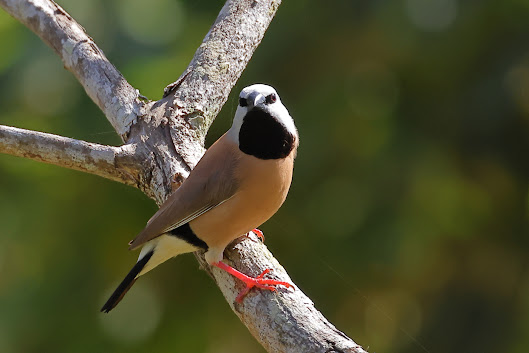 Good day, Mr Macleay, Mrs Macleay - and what would you be fancying for luncheon?
Good day, Mr Macleay, Mrs Macleay - and what would you be fancying for luncheon?Black tree ants? An excellent choice. Not so fizzing on the palate as green ants. And no risk of a savage bite to the tongue or face.
Today's delicacy comes au naturelle. There's the usual subtle tang of exotic wild fruit and a delicate hint of licorice. You'll find the lasting aftertaste gives way to a cleansing astringency with a not unpleasant flintiness.
And the wee beauties come replete with the usual valuable proteins and many minerals. A health food from kindly Mother Nature.
Bon appetit!
Well, perhaps it wasn't quite like that in Tyto today. But a pair of Macleays Honeyeaters did show a huge liking for the black ants (about two-thirds size of greens). The ants were picked off singly from amid a few dead guava leaves and a cluster of small branches. The feasting continued for more than five minutes after I came upon the action in a shaded patch of bush.
It is probably not uncommon feeding by birds, given their wide tastes and the great numbers of ants. But it's something I'd not noticed and was certainly an encouragement to try an ant or two. (Feeding spritzy fizzy green tree ants to tourists is a popular stunt on 'bush tucker' backpacker trips. They can and do bite!) The black ants were as described by my mock maitre'd.
I'd include a picure of an ant, but it was hard enough snapping one of the birds. And between us we polished off the branchful.
 Eating larger fare was the first Pelican to splash down for 2008. Competition mainly for the Darters and Little Pied Cormorants. The Pelican's gruff croaks were not the only new sound today. Earlier, the immature Rufous Songlark began some tentative vocals, suggesting it's male (but I'm not sure). Rather sweet snatches of twitter and chitter, all at a level to be heard only within 10 metres of the bird. With luck there'll be louder bursts later.
Eating larger fare was the first Pelican to splash down for 2008. Competition mainly for the Darters and Little Pied Cormorants. The Pelican's gruff croaks were not the only new sound today. Earlier, the immature Rufous Songlark began some tentative vocals, suggesting it's male (but I'm not sure). Rather sweet snatches of twitter and chitter, all at a level to be heard only within 10 metres of the bird. With luck there'll be louder bursts later.In all, 70 species seen in about five hours, the other highlights being mature and juvenile Fan-tailed Cuckoos, Swamp Harrier, Dusky Honeyeaters, and the female Cotton Pigmy Goose that may be thinking of attachment to a male Green Pigmy Goose.

















